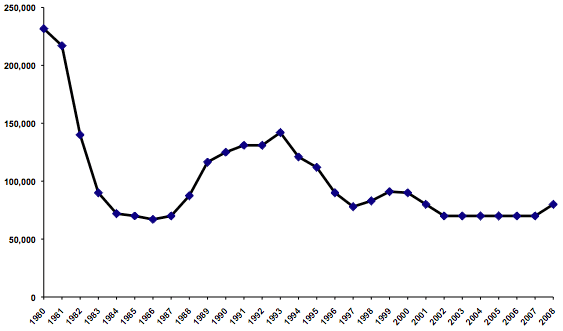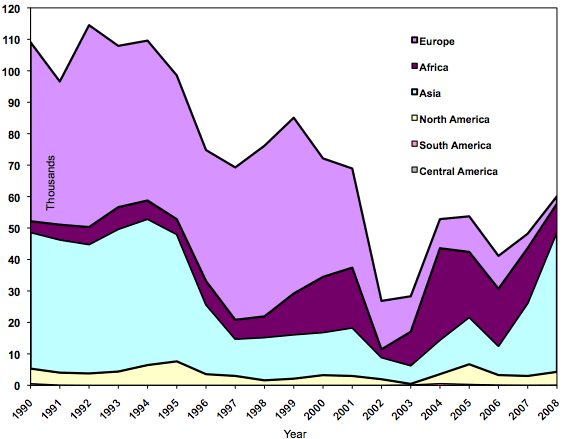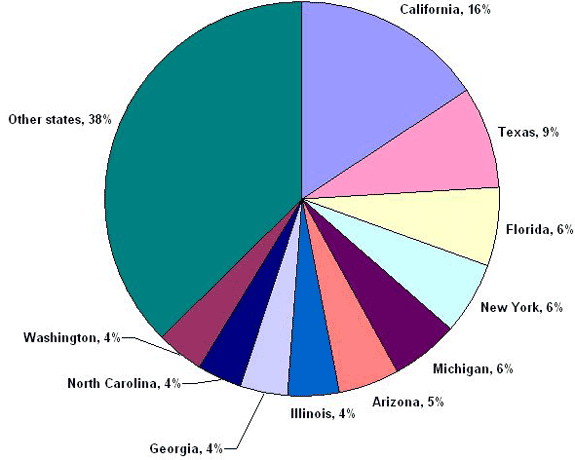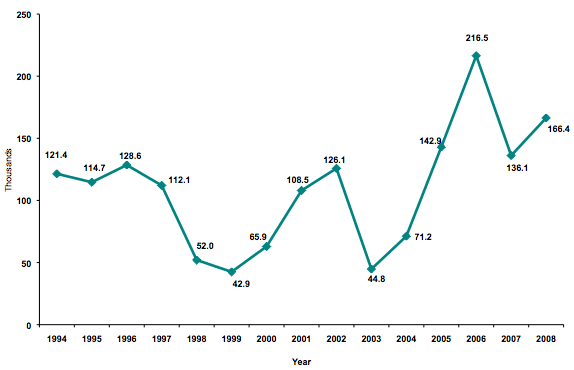Refugees and Asylees in the United States
Source Spotlights are often updated as new data become available. Please click here to find the most recent version of this Spotlight.
For many people seeking protection, a neighboring country is often the first destination. While some may return home, others may be resettled to a third country. Indeed, the refugee/asylee channel is one of three ways foreign-born nationals can legally immigrate to the United States, along with family reunification and employment (see Spotlight on Legal Immigration to the United States).
This Spotlight examines the data on persons admitted to the United States as refugees and those granted asylum in 2008. It also provides the number of refugees and asylees who received lawful permanent resident (LPR) status in 2008.
The data come from the 2008 Annual Flow Report on Refugees and Asylees and the 2008 The Annual Flow Report on U.S. Legal Permanent Residents, published by the Department of Homeland Security's Office of Immigration Statistics (OIS).
Note: all yearly data is for the government's fiscal year (October 1 through September 30).
Click on the bullet points below for more information.
Definitions
- Refugees and asylees are aliens who are unable or unwilling to return to their country of origin or nationality because of persecution or a well-founded fear of persecution.
- Asylum seekers can submit an asylum request either affirmatively or defensively.
- Both refugees and asylees are eligible to apply for lawful permanent resident (LPR) status after one year of continuous presence in the United States as a refugee or asylee.
Refugee Data
- The annual ceiling for refugees admitted to the United States through the resettlement program increased from 70,000 to 80,000 in 2008.
- More than 60,000 refugees were admitted to the United States in 2008 through the resettlement program.
- Nationals of Burma, Iraq, and Bhutan accounted for nearly two-thirds of all refugee arrivals in 2008.
- California and Texas received the largest numbers of resettled refugees in 2008.
- Of the nearly 50,000 Iraqi refugees admitted in the United States between 1991 and 2008, 29 percent arrived in 2008.
- More than 40 percent of all refugee arrivals are principal applicants.
Asylee Data
- Nearly 23,000 individuals (principals and their immediate family members) were granted asylum in 2008.
- China, Colombia, and Haiti accounted for more than a third of all persons granted asylum in 2008.
Adjusting to Lawful Permanent Resident (LPR) Status Data
- More than 166,000 refugees and asylees adjusted their status to LPR in 2008.
- Refugees accounted for more than half of all refugee/asylee LPR status adjusters in 2008.
|
|
||
|
Definitions
Refugees and asylees are aliens who are unable or unwilling to return to their country of origin or nationality because of persecution or a well-founded fear of persecution.
Refugees and asylees are similar in that they are aliens who are unable or unwilling to return to their country of origin or nationality because of persecution or a well-founded fear of persecution on account of race, religion, nationality, membership in a social group, or political opinion.
In the United States, the main difference between refugees and asylees is the location of the person at the time of application. Refugees are generally outside of the United States when they are considered for resettlement, whereas asylum seekers submit their applications while they are physically present in or at a port of entry to the United States.
Concurrently, refugees and asylees also differ in the way they are treated by immigration and refugee law at the time of application and admission (see sidebar).
Aliens seeking asylum in the United States can submit an asylum request either affirmatively or defensively.
An asylum seeker present in the United States may submit an asylum request either with a US Citizenship and Immigration Services (USCIS) asylum officer (affirmative request), or, if apprehended, with an immigration judge as part of a removal hearing (defensive request). During the interview, an asylum officer will determine whether the applicant meets the definition of a refugee.
If the case is denied, an applicant may appeal for additional hearings with the Board of Immigration Appeals or, in some cases, with federal courts.
Aliens may also request asylum at the port of entry (POE) by informing an inspection officer that he/she is fleeing persecution or seeking asylum. The individual is then referred to an asylum officer for a credible fear interview to determine if he/she has a verifiable fear of persecution. If the claim for asylum is verified, the case is referred to an immigration judge and the individual placed in nonexpedited removal proceedings. If the claim is denied, the individual will be subject to removal.
Both refugees and asylees are eligible to apply for lawful permanent resident (LPR) status after one year of continuous presence in the United States as a refugee or asylee.
As lawful permanent residents, refugees and asylees have the right to own property, attend public schools, join certain branches of the US Armed Forces, travel internationally without a visa, and, if certain requirements are met, apply for US citizenship.
Until 2005, there was a 10,000 annual limit on the number of asylees who were authorized to adjust their status to LPR. The implementation of the REAL ID Act eliminated that cap. No annual limit has existed on the number of refugees eligible to adjust to LPR status.
Refugee Data
The annual ceiling for refugees admitted to the United States through the resettlement program increased from 70,000 to 80,000 in 2008.
The admission ceiling for refugees for 2008 was set at 80,000, 10,000 higher than the ceiling in 2002 through 2007 in response to an expected rise in refugee resettlement from Iraq, Iran, and Bhutan. Despite this recent increase, the current ceiling is 65 percent lower than the 1980 ceiling (231,700) (see Figure 1).
The number of persons who may be admitted to the United States as refugees each year is established by the president in consultation with Congress. At the beginning of each fiscal year (during the month of October), the president sets the number of refugees to be accepted from six global regions, as well as an “unallocated reserve” if a country goes to war or more refugees need to be admitted regionally. In the case of an unforeseen emergency, the total and regional allocations may be adjusted.
The 80,000 worldwide ceiling for 2008 breaks down as follows: 16,000 from Africa (-4,000 compared to 2007), 20,000 from East Asia (+5,000), 3,000 from Europe and Central Asia
(-12,000), 3,000 from Latin America and the Caribbean (-2,000), and 28,000 from Near East and South Asia (+23,000); 10,000 were unallocated (same as in 2007).
|
|
||
|
More than 60,000 refugees were admitted to the United States in 2008 through the resettlement program.
In 2008, 60,108 individuals were admitted to the United States as refugees. This figure represents a 46.1 percent increase compared to the corresponding number in 2006 (41,150) and a 24.7 percent increase over 2007 (48,218) (see Figure 2).
|
|
||
|
Nationals of Burma, Iraq, and Bhutan accounted for nearly two-thirds of all refugee arrivals in 2008.
Nationals of Burma, Iraq, and Bhutan represented 37,282 persons, or 62.0 percent, of all refugee admissions in 2008 (see Table 1). Altogether, nationals of the top 10 countries made up 91.9 percent of the 60,108 refugee arrivals in 2008. In addition to the top three, these countries include Iran, Cuba, Burundi, Somalia, Vietnam, Ukraine, and Liberia.
According to the Department of State, the United States expects to accept at least 17,000 Iraqis, 12,000 Bhutanese, and 5,500 Iranians in 2009.
The top 10 countries of origin of refugee arrivals in 2007 were Burma (13,896), Somalia (6,969), and Iran (5,481); these three countries accounted for 54.6 percent of the 48,218 refugees in 2007. Between 2007 and 2008, the number of refugees from Iraq increased nearly ninefold whereas the number from Somalia dropped almost threefold.
|
|
||||||||||||||||||||||||||||||||||||||||||||||||||||||||||||||||||||||||||||||||||||||||||||||||||||
|
||||||||||||||||||||||||||||||||||||||||||||||||||||||||||||||||||||||||||||||||||||||||||||||||||||
Of the nearly 50,000 Iraqi refugees admitted in the United States between 1991 and 2008, 29 percent arrived in 2008.
According to 2009 estimates from the United Nations High Commissioner for Refugees, there are about 4.8 million Iraqis who are displaced, including 2.6 million internally displaced, nearly 2 million in neighboring countries, and 280,000 persons who sought refuge in Iraq from Palestine, Iran, and Syria.
Between 1991 and 2008, the United States admitted 48,216 Iraqi refugees or 3.8 percent of the 1.3 million refugees the United States admitted during this period. The number of admitted refugees from Iraq increased after the 1991 Persian Gulf War but then dropped to a trickle (66 refugees) in 2004 (see Figure 3).
The United States admitted 1,608 refugees from Iraq in 2007 and 13,823 in 2008. The State Department expects to admit at least 17,000 refugees from Iraq in 2009.
California and Texas received the largest numbers of resettled refugees in 2008.
In 2008, the largest percentages of refugees admitted to the United States were resettled in California (15.8 percent or 9,472) and Texas (8.5 percent or 5,113). Large numbers of refugees also were resettled in Florida (6.2 percent or 3,715), New York (6.0 percent or 3,628), Michigan (5.5 percent or 3,292), and Arizona (5.0 percent or 3,006). Almost half of all refugees were resettled in one of these six states (see Figure 4).
In 2007, the top five states were California (13.9 percent or 6,699), Texas (9.1 percent or 4,394), Minnesota (6.6 percent or 3,198), New York (6.2 percent or 2,978), and Florida (5.6 percent or 2,691), accounting for 41.4 percent of all 48,218 resettled refugees.
|
|
||
|
More than 40 percent of all refugee arrivals are principal applicants.
Forty-two percent (25,355) of all refugees admitted in 2008 were principal applicants. They were accompanied by dependent children (40.5 percent or 24,347) and spouses (17.3 percent or 10,406).
In 2007, of the 48,217 refugees, 41.3 percent (19,911) were principal applicants, 43.3 percent (20,892) were children, and 15.4 percent (7,414) were spouses.
|
|
||
|
Asylee Data
Nearly 23,000 individuals (principals and their immediate family members) were granted asylum in 2008.
In 2008, 22,930 principals and their immediate family members were granted asylum. This represents a 8.7 percent decrease over the corresponding number in 2007 (25,124) and a 12.5 percent decline compared to 2006 (26,203).
Of the 22,930 asylees, 53.1 percent (12,187) were granted asylum affirmatively and 46.9 percent (10,743) were granted asylum defensively.
China, Colombia, and Haiti accounted for more than a third of all persons granted asylum in 2008.
Nearly 5,500 persons from the People's Republic of China, 1,646 from Colombia, and 1,237 from Haiti were granted asylum, accounting for 36.6 percent of all individuals who received asylum status in 2008. Those granted asylum from Venezuela (1,057), Iraq (1,022), Ethiopia (899), and Russia (574) accounted for another 15.4 percent. Together, nationals of these seven countries make up over half of all individuals who received asylum status in 2008 (see Table 2).
|
|
|||||||||||||||||||||||||||||||||||||||||||||||||||||||||||||||||||||||||||||||||||||||||||||
|
|||||||||||||||||||||||||||||||||||||||||||||||||||||||||||||||||||||||||||||||||||||||||||||
Adjusting to Lawful Permanent Resident (LPR) Status Data
More than 166,000 refugees and asylees adjusted their status to LPR in 2008.
In 2008, 166,392 refugees and asylees adjusted their status to LPR, a 22.2 percent increase over the number in 2007 (136,125) but a 23.1 percent decline compared to 2006 (216,454) (see Figure 5).
|
|
||
|
Refugees accounted for more than half of all refugee/asylee LPR status adjusters in 2008.
Of the 166,392 refugees and asylees who adjusted their status to LPR in 2008, 90,030 (54.1 percent) were refugees and 76,362 were asylees (45.9 percent).
Additional Resources
The Annual Flow Report on Refugees and Asylees: 2008. Available online.
The Annual Flow Report on U.S. Legal Permanent Residents: 2008. Available online.
Definitions of terms can be found at the website of the Office of Immigration Statistics. Available online.
Office of Refugee Resettlement
Kelly O'Donnell and Kathleen Newland. The Iraqi Refugee Crisis: The Need for Action (Washington, DC: Migration Policy Institute, 2008). Available online.
UNHCR Country Profile: Iraq. Available online.






